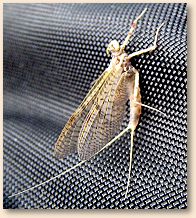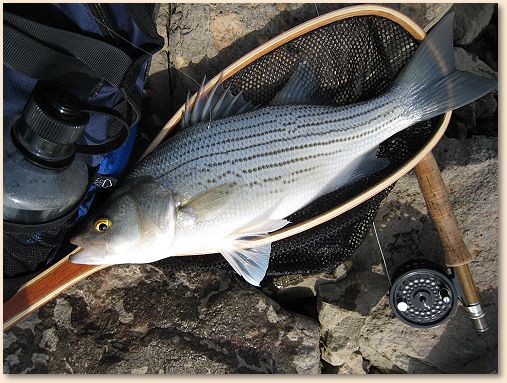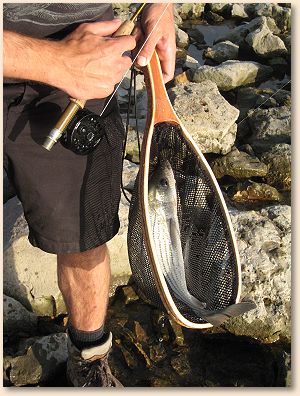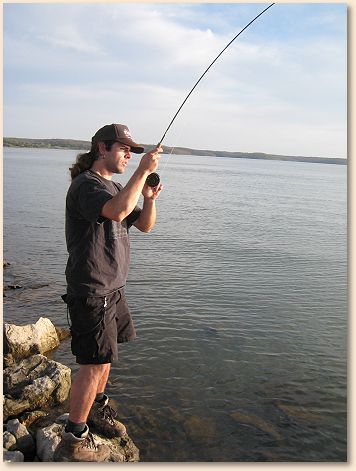|
It's 8:00 p.m. Saturday, April 21st. My friend Konnie and I are
heading into the country to a spot where a family of Barred Owls
puts on quite a show calling to one another after sundown. Our
route out of town takes us across the dam of Clinton Lake, a big
federal reservoir west of Lawrence.
As we're crossing the dam, up ahead at the drawdown tower a number
of vehicles are parked. A couple of guys are walking amongst the
vehicles. I think nothing of it; this is a common sight. The
waters of Clinton Lake lie west of the dam and at sundown the
western sky is often lighted beautifully. Many people will drive
to the drawdown tower and park just to watch the sunset and maybe
photograph the sometimes spectacular scene.
Konnie was driving and we were yakking away, so it was blind luck
that made me turn my head in time to see, hanging near the right
knee of one of the guys walking toward me, a flash of movement and
light reflecting off a fish – no, more than one – off two or three
fish on a stringer this guy was carrying…and those babies looked
BIG. I caught just this one glimpse as we zipped past. I couldn't
tell for sure but the fish appeared to be crappies, maybe white bass.
Definitely not channel cats. They were just so big!
There was traffic behind us on this narrow, no-shoulder road. The
only way to verify what those fish were was to drive clear to the
south end of the dam, turn around and make a 1-mile drive back to
the outlet tower. Konnie was willing to do this but after agonizing
a few moments I decided to let it slide. Even if that lucky fisherman
was still there by the time we returned, it would strike him as rude
if a stranger hurried up asking to see his fish, inquired what he caught
them on, etc., etc. Like some nosy tourist.
No. I would try to find out what those fish were the old fashioned
way: by climbing over the guard rail, walking gingerly down Clinton
Dam's long, rocky face to the water's edge and catching some myself.
But when could I possibly go? There have been so many weeks of
high wind this spring. So when Sunday dawned and its 35-mph south
wind forecast proved accurate, I stayed indoors all day long in an
excruciating can't-go-fishing funk. The only thing that made the
howling wind bearable, ironically, were the recurring visions I
had of that guy's stringer of fish. This wind had to quit sometime
and when it did I needed to be ready for a serious fishing trip. I
thus set about going through my entire fly collection segregating
nymphs, minnow imitators and what few floating flies I own into
three small boxes that would go into my fanny pack.
Normally I don't concern myself with floating flies. You ask
me, they're a pain in the neck – all that fussing with floatant
gel or drying powder, which only delays the inevitable waterlogging
and must be re-applied regardless each time a fish takes the fly
under and slobbers it up with mouth slime. However, over the last
three years I've been given too many tips by the folks at K&K Fly
Fishers, Cabela's, Yager's, plus members of Lawrence's Free State
Flyfishers Club – tips about how wild the surface action can be at
Clinton Lake along the face of the dam at sundown if the white bass
and crappies move into the rocks to feed on mayflies. I'd even heard
that the occasional wiper (a white bass/striped bass hybrid) takes
a mayfly pattern. So to cover all the bases I held my nose and pulled
a few dry flies out of mothballs.
It's now Monday morning, April 23rd, pre-dawn. I'm in bed half
asleep when the silence outside cuts through my foggy brain and
I sit up with a start. I peek outdoors. The tree branches aren't
moving. I step out the back door. No wind. I turn on the TV and
check the forecast. Today: north wind 5-mph, changing to 5-mph east
wind around sundown. 5-mph? This can't be a Kansas wind forecast,
but it is!
Okay, calm down, man. Think. The guy carrying those fish
Saturday evening, odds are he caught them around sundown,
right? That means there's no need to rush out to the lake;
I can skip the morning fishing. Still, I should get out there
more than a couple of hours before sundown, just in case.
Early afternoon will do fine (I hope).
But "early afternoon" means I might have to spend six or eight
hours standing on rocks in the open waiting for the feeding
action to start, and during that long wait I'd be exposed to
overhead hot sun, hunger, thirst and eventually the evening
chill.
So wimp that I am, at 1:30 that afternoon when I stepped over the
guardrail and began descending the dam's rocky face, on my back
was a hiker's day pack filled with fleece clothing, food and two
liters of water. Mountain climbers nearing a summit will shed
their big main packs for a final push; they call their light bags
an "assault pack." Today, picking my way downslope toward my own
"summit," that's what my day pack was for me.
I'd finally got here, and days earlier than I'd dared hope. Got
here where unknown big fish lurk and I would stay on this dam and
fish its entire length if need be and not stop until the sundown
western sky faded to black starlight if that's what it took to
find out what kind of fish that guy had caught two days earlier.
Seeking shelter from the sun seemed a practical move upon reaching
the water, so the first place I fished was the shaded area underneath
the elevated walkway that stretches from the crest of the dam to the
lake's drawdown tower. A small but deep pocket of water lies directly
below this walkway, a pocket that gets heavy fishing pressure because
of how near it is to the descent trail most fishermen use when hiking
down from the parking area above. Nobody was here so I tried the
pocket for 45 minutes, but without a single touch.
I was about to move elsewhere when Old Reliable (a #10 flashback
Hare's Ear Nymph) snagged on a submerged rock that suddenly grew
fins and began to slowly leave. The beast's ponderous head wag
snapped my 5-lb. test tippet like it wasn't there. What followed
was the appearance of two massive surface swirls created by what
must be a very broad and powerful tail fin. I never saw the fish.
From its display of brute strength I deduced this was either a
big channel catfish here looking for crappie eggs, or a flathead
catfish hunting spawning crappies. Both possibilities assumed
the presence of crappies which, if not actually present at this
moment would doubtless arrive soon. Crappies are primarily what
I came here to catch, so in hopes of discouraging any more
catfish hits I stripped in my now empty leader and tied on a yellow
bead-eye Wooly Bugger-type fly purchased at Yager's last year.
It's a proven crappie killer.
My first cast went right back into the area where The Creature had
just broken me off. Halfway in, the yellow Bugger took a vicious
hit that yanked my line so hard the tippet once again instantly
parted. Wow, two quick breakoffs by big fish! What's going on
here? This second fish couldn't have been a crappie, no way; it
had to be a white bass, a big one. Alright then: if the whites
are running this big I'd better make an equipment adjustment or
I'll be out of flies before sundown.
I clipped off what little remained of the 5-lb. test terminal section
of my leader, leaving a 15-inch length of 6-lb. test "repair tippet."
Onto it I tied one of Rick Zieger's light tan hairball flies, a
pattern he likes for crappie. Thirty minutes of it brought no hits.
I switched to a Mickey Finn minnow imitator and thirty minutes of it
brought no hits, either. There just wasn't anything going on anymore,
it seemed. Surface feeding swirls weren't happening anywhere, no
surprise since it was still so early in the afternoon.
Then I bent down to pick up my day pack prior to relocating, and all
the encouragement I needed to stay on the hunt until the bitter end
was clinging quietly to my day pack.

Bingo: a mayfly is resting on my pack in broad daylight, proof that
mayflies indeed live along this dam. To my thinking this one fragile
insect clinched it – that the tips so many people had given me were
true and sooner or later game fish would begin arriving here to eat
mayflies by grabbing winged adults off the surface or intercepting
nymphs rising to hatch. It was just a matter of time.
I clipped off the Mickey Finn, tied on another Old Reliable (to imitate
the mayfly nymphs soon to rise) then found a flat rock to sit on while
I ate one of my sandwiches and drank some water. No telling when the
afternoon/evening action might start and I didn't want to go into battle
hungry and thirsty.
Not long after I finished this rest break and resumed fishing, two
young guys showed up who had walked down from the dam road above.
One soon walked behind me and headed south down the face of the dam,
not cutting back to the water to begin casting until he'd moved well
past me. I greatly appreciated the "space cushion" he gave me, as
my intention was to proceed south myself. If his intentions were
ike mine, to keep moving south away from the drawdown tower, I would
certainly return his courtesy by making long leapfrogs past his
position each time I elected to move.
Not many minutes passed and he came walking back the way he'd come,
I guess so he could stand next to his buddy and visit. Dangling from
his rod's tip top was a triple-treble minnow lure that looked to be a
Rapala. With his ultralight rod he was casting this lure way out into
the lake, 30-to-40 yards out, easy. I paid no attention to this until
he started catching fish and I still wasn't. There one came, a
silver-colored fish flopping loudly at his feet.
"If you don't mind me asking: Is that a white bass you just caught?"
"No, it's a wiper," he answered.
"Huh? A wiper? You mind if I come over and look? I've never seen one;
at least, not a fish I know was a wiper. People have told me how to
identify them, but it's been so long I forgot."
Permission to approach was granted and I eased across the rocks
to inspect the fish. Two little spots on its tongue, a
streamlined profile plus almost unbroken black stripes along
its sides are the identifying features. Very pretty fish.
Justin Shiney, the Lawrence fisherman who'd caught this wiper
and pointed out its identifying features, released it back into
the lake. I thanked him and returned to my spot. We were standing
close enough and the wind was light enough that our voices carried
far enough we could visit. Justin began educating me about wipers;
not all at once but bit by bit over the next couple of hours. I
was all ears.
Occasionally – every 40 or 50 casts – Old Reliable would absorb a
hard hit from a fish that would quickly get off. Justin suspected
these were wiper hits but wasn't certain because he'd never seen or
even heard of a wiper taking a Hare's Ear Nymph, or any artificial
fly for that matter. Justin's experience was strictly that of a lure
fisherman. And me? Hey, I didn't know either, not really, if wipers
will take a nymph. What if they only eat minnows?
Now I had another hit, and it felt connected. Very solidly connected,
and to a fish that behaved like it didn't really want to go anywhere.
"This could be a crappie," I told Justin, and sure enough it was.
A good one, too. I stringered it, pendulumed the white crappie
slab back into the lake and bowline knotted the end of my 10-ft.
stringer to a belt loop. I checked my watch; it was 5:05 p.m.
Justin and his friend, Ian, now began steadily catching wipers.
Many other fishermen had arrived by this time, but they were
bunched up back around the drawdown tower and weren't having any
luck. Ian and Justin were putting on a clinic for anybody alert
enough to pay attention, and it was my good fortune to be standing
close to watch and learn.
"They're hitting within the first 10 feet of my retrieve," Justin
told me. "They're jumping right on it, almost immediately."
Okay, I gave that little tidbit a chew. I'd been fishing Old Reliable
deep all day, running him as close to the rocky bottom as I dared, on
the assumption that deep is where the fish must be. I took a few
seconds to watch Ian and Justin casting. They were commencing their
retrieve the instant their lures splashed down. I was throwing a
tiny Hare's Ear Nymph whereas they were throwing long Rapalas –
seemingly an insurmountable mismatch in tackle. But Justin had
earlier told me he was using the original balsa version Rapala.
That lightweight lure combined with his presentation could only
mean the wipers were cruising close to the surface. I decided to
abandon my deep nymphing approach and start swimming Old Reliable
just below the surface using 2-foot line strips. This presentation
of a nymph might not interest a wiper, but it might be just what
the crappies are looking for if they've moved into the surface
zone and are sharing space with the wipers.
A few casts later my line stopped, I raised the rod and something
punched the throttle and tried to set a new world record in the
40-yard dash. Line melted off my reel in a blur, nearly taking me
into the backing before the fish made a 90-degree left turn and stood
its ground, fighting in place. I battled this fish for many minutes
and was beginning to think it was a carp or channel cat judging by its
stubborn struggle. Finally, the fish ran out of steam and I horsed it
into view, saw a shining profile with black stripes, slid it toward
the rocks and with some difficulty worked it into the mouth of my
trout landing net.

"That," said Justin, who'd come over to watch, "is a wiper.
It's a good one, too."
I rammed the tip of my forceps through the fish's lower jaw,
preparing to grab my stringer tip and pull it back through.
"Better measure him before you string him," warned Justin.
"There's a length limit on wipers."
"Huh? Length limit? Really? I didn't know."
Reaching into a pocket, Justin produced a small metal tape
measure. My wiper was a shade over 18 inches long.
"He's legal," said Justin, "if you want to keep him."
"You bet I want to keep him. Well," I hesitated, "I do if wipers
are good to eat. I don't know. Are they?"
"I think they are; I love eating them," Justin said. So onto
the stringer went my career-first wiper. The slab crappie I'd
caught earlier (later measured at 13-inches) looked like a bait
shop bluegill next to the length and bulk of this wiper.
A few minutes later Justin leapfrogged me to the south. After
a half hour passed with no hits I in turn leapfrogged Justin.
Soon I had my next wiper hit. This fish took Old Reliable almost
at the instant of splashdown, which was noteworthy because I'd made
a maximum-distance cast with my OO-wt. Sage. In a heartbeat the
fish was into my backing – the first time any fish has taken me
into this ultralight rig's backing. Glancing down at my spool
and seeing that squeaky clean braided line disappearing – it was
so exciting.
The fish bolted straight out into the lake then stopped, like the
wiper I caught had done. Except this one turned south and ran
parallel along the face of the dam, taking yet more backing off
my reel. What in the world do we have here? Suddenly the line
went slack; the fish was off. Probably broke my tippet. But no;
Old Reliable was still there when I stripped the leader back into view.
At this point I remembered a purchase made a week earlier at the
Cabela's Fly Shop in Kansas City, KS. I'd bought a spool of Rio
3X (8 lb. test) tippet, thinking it would be useful for reestablishing
the factory taper on any 4X leaders that lost too much of their terminal
ends. Something to extend the lifespan of my most often used leaders.
The power and dazzling speed of these wipers had greatly impressed
me, making me fear for the lives of my #10 nymphs. To safeguard
my dwindling nymph supply I clipped off the 4X (6 lb. test) tippet
section I'd been working with and surgeon knotted 18 inches of 3X
tippet to my leader. There would be no step-down to a thinner
diameter. It felt funny threading 3X tippet through Old Reliable's
eye, but the situation justified this act of self-defense.
Fifteen minutes later, about halfway back to shore came another
wiper-type hit on my nymph followed by a bitter struggle. Just
when I got this fish near shore I reached around to my left back
pocket feeling for my net…and it wasn't there. Alarmed, I looked
on the rocks behind me; no net. Great: I must have left it at the
spot where I caught that first wiper, and in my excitement had
forgotten it when I leapfrogged Justin.
Hearing me grieve at not having a net, Justin looked back where I'd
been standing and spotted my net. He grabbed it and made his way
across the rocks to my new spot, handed me the net and I landed the
wiper. I almost lost the fish anyhow because on my first lift from
below its body would not fit through the hoop and slid off. I tried
again and got him.
"That's another keeper, I'll bet," said Justin. He proved it by
measuring the fish at a hair under 19-inches. I stringered the
wiper, took a deep breath and scanned the shoreline for a flat rock
to sit down on quick; I needed a rest.
"Godamighty!" I panted, "I don't know if I can take another couple
f hours of this! These wipers are a trip!"
"Better not keep any more of 'em," advised Justin. "There's a
2-fish creel limit on wipers."
Here is where I began seriously thanking my lucky stars that I'd run
into Justin Shiney. I began counting the ways he'd helped me. First:
telling me that wipers are in this lake in good numbers. Second:
telling me they are hitting real good right now. Third: showing
me what a wiper looks like. Fourth: demonstrating how he catches
them (which let me mimic his presentation). Fifth: telling me
about the length limit. Sixth: finding my landing net and bringing
it to me in a moment of dire need. Seventh: telling me about the
2-fish creel limit.
I'd come out here today woefully ignorant – illegally ignorant – of
what this wiper game is about. Likely I'd been saved from a court
hearing, is how I looked at it.
I kept fishing anyway, though. Catch & Release Time, amigos, just
because it's so thrilling being here I don't want to leave. The next
wiper that struck took Old Reliable like a midnight express snags a
mail sack off the depot hook. The hit came halfway through the retrieve
when loops of stripped line were floating on the lake surface at my feet.
This line got yanked back through the rod guides the other way so violently
that before I could react a loop whipped up into the air and wrapped around
my hand and the reel. This was all the advantage that wiper needed. Snap!
It broke me off, and another #10 HEN went bye-bye. Only five left now.
Like a punch drunk boxer I tie on another and with wobbly legs keep casting. Why not?
Wham! Another wiper cold-cocks me, turns for open water and kicks in
the afterburner. It's another good fish, I can tell. I glance over
at Justin who is standing 30 feet away. He'd noticed the hit. Hmmm...
why not, indeed?
"Hey Justin, you care to give this a try?"
Boy, did he ever; he quickly came over and I handed him a 00-wt. Sage
rod bent deeply under a big wiper's initial run, reel handle a blur,
spool already into the backing.

"That reel has a drag," I told him, "If you want more, lay your open
palm against the spool's edge. Watch that reel handle; it can hurt
your knuckles. These fish really go so let loose when he runs; if
the handle tangles in your fingers he'll break you off."
Justin proceeded to do a better job fighting a wiper than I'd done
with the two I'd caught. He subdued his fish in far less time and
looked more efficient doing it. Maybe I'll get better if I hook more
wipers in the future. Tonight I may have been overly conservative
in my fighting technique due to fears of over-pressuring a strong fish
and breaking it off, or pulling out the hook. Not Justin: he worked
his fish to shore fairly quickly, I handed him my net and he bagged
his wiper.

His fish measured 19 ˝ inches. What a beauty!
"Well, hey man, you're the guy who landed this fish, not me,"
I told Justin, "You want to keep him?"
"Yeah, thanks! All the ones I've caught tonight have been just a
little bit too short." He extracted Old Reliable from the wiper's
jaw, walked back across the rocks and added his 19-incher to a
stringer holding two keepers that Ian had caught.
A few minutes later Justin's cell phone rang; he was informed
that a dinner date had been made and he was invited to attend.
"We gotta leave," he told me.
"If you guys go, I go. I'll get in trouble out here without adult
supervision," I said half-jokingly, alluding to all the advice and
help Justin had given me.
On our hike up the face of the dam, Ian told me that the two keepers
he'd caught were his career-first wipers, too. Well, that explained
how come his shoes and mine were floating above ground most of the
way back to our trucks. Wow, wow, WOW – what a trip!

Special Note:
In waters managed by the Kansas Dept. of Wildlife & Parks, forty
seven (47) lakes have creel and length regulations that allow
possession of two (2) wipers if each fish is a minimum 18-inches long.
Thirty eight (38) other bodies of water allow the taking of two (2)
wipers of any length.
In Cheney Reservoir two (2) wipers may be kept, but each must
be a minimum of 21-inches long.
In Coffey County Lake just one (1) wiper may be kept, and it must
be a minimum of 21-inches long.
For any Kansas lake you know of that harbors wipers, the safest
thing is to check the rules that apply to that particular lake.
The information you need is in the Kansas Fishing Regulations
Summary, available on the Department's website:
www.kdwp.state.ks.us. ~ Joe
About Joe:
 From Douglas County, Kansas, Joe is a former municipal and
federal police officer, now retired. In addition to fishing, he hunts
upland birds and waterfowl, and for the last 15 years
has pursued the sport of solo canoeing. On the nearby
Kansas River he has now logged nearly 5,000 river miles
while doing some 400 wilderness style canoe camping
trips. A musician/singer/songwriter as well, Joe recently
retired from the U.S. General Services Adminstration.
From Douglas County, Kansas, Joe is a former municipal and
federal police officer, now retired. In addition to fishing, he hunts
upland birds and waterfowl, and for the last 15 years
has pursued the sport of solo canoeing. On the nearby
Kansas River he has now logged nearly 5,000 river miles
while doing some 400 wilderness style canoe camping
trips. A musician/singer/songwriter as well, Joe recently
retired from the U.S. General Services Adminstration.
Joe at one time was a freelance photojournalist who wrote the
Sunday Outdoors column for his city newspaper. Outdoor
sports, writing and music have never earned him any money,
but remain priceless activities essential to surviving the
former 'day job.'
|






 From Douglas County, Kansas, Joe is a former municipal and
federal police officer, now retired. In addition to fishing, he hunts
upland birds and waterfowl, and for the last 15 years
has pursued the sport of solo canoeing. On the nearby
Kansas River he has now logged nearly 5,000 river miles
while doing some 400 wilderness style canoe camping
trips. A musician/singer/songwriter as well, Joe recently
retired from the U.S. General Services Adminstration.
From Douglas County, Kansas, Joe is a former municipal and
federal police officer, now retired. In addition to fishing, he hunts
upland birds and waterfowl, and for the last 15 years
has pursued the sport of solo canoeing. On the nearby
Kansas River he has now logged nearly 5,000 river miles
while doing some 400 wilderness style canoe camping
trips. A musician/singer/songwriter as well, Joe recently
retired from the U.S. General Services Adminstration.